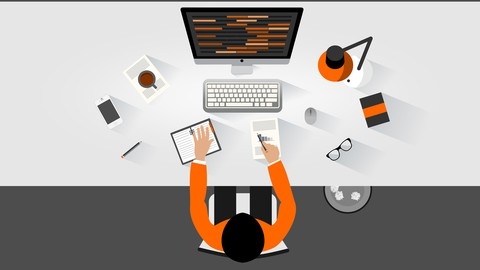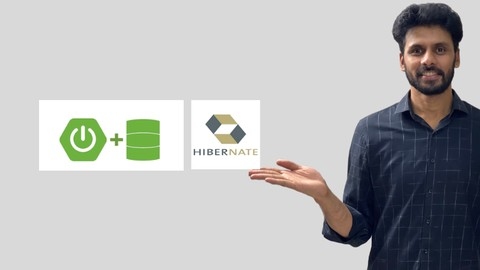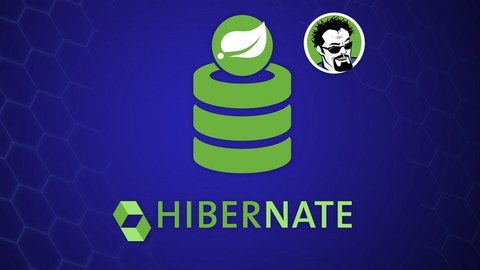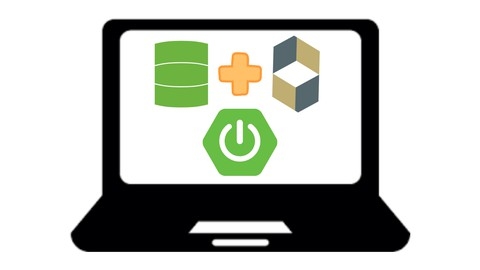JPA (Java Persistence API) is a powerful technology that simplifies the way Java applications interact with databases.
It provides a standardized way to map Java objects to database tables, allowing developers to work with data in a more object-oriented manner.
By learning JPA, you can reduce the amount of boilerplate code you need to write for database access, improve the maintainability of your applications, and boost your productivity as a Java developer.
Finding a comprehensive and well-structured JPA course can be a challenge, especially with the abundance of options available online.
You’re looking for a course that covers the core concepts of JPA, provides hands-on examples, and teaches you best practices for designing and implementing data access layers in your Java applications.
Based on our research, the best JPA course on Udemy overall is Master Hibernate and JPA with Spring Boot in 100 Steps.
This course offers a practical and step-by-step approach to learning JPA with Hibernate, a popular implementation of the JPA specification.
It covers a wide range of topics, from basic entity mapping to advanced querying techniques, and provides numerous examples to help you solidify your understanding.
However, depending on your specific needs and learning preferences, other JPA courses might be a better fit.
Continue reading to explore our curated list of recommendations, including courses tailored for beginners, experienced developers, and those interested in specific JPA frameworks or features.
Master Hibernate and JPA with Spring Boot in 100 Steps
You’ll start with a gentle introduction to Spring Boot, covering essentials like setting up projects, building APIs, understanding auto-configuration, and leveraging developer tools.
This lays the groundwork for the main course content.
The course then dives deep into the transition from JDBC to JPA, guiding you step-by-step.
You’ll learn to work with databases like H2, write queries, and map data to Java objects elegantly using JPA annotations.
Before going further with JPA, you’ll get a solid grounding in unit testing with JUnit.
This ensures you can write robust, testable code as you explore advanced JPA concepts like relationships (OneToOne, OneToMany, ManyToMany), inheritance mappings, and queries (JPQL, Criteria).
Transaction management, an often overlooked but crucial aspect, is covered in depth, including ACID properties, isolation levels, and implementation strategies.
As you progress, you’ll leverage powerful tools like Spring Data JPA for simplified data access and Spring Data REST for building hypermedia-driven RESTful repositories.
The course doesn’t stop there - it dives into performance tuning tips for Hibernate/JPA, caching strategies, soft deletes, and integrating with embedded objects and enums.
You’ll also learn good practices for designing great JPA applications.
Throughout the course, you’ll have access to FAQ videos addressing common queries, like connecting to different databases, choosing between JPA and JDBC, and general best practices.
If you’re new to Spring, there’s even a bonus section introducing the Spring framework, covering core concepts like dependency injection, loose coupling, and exploring Spring projects/modules.
Java Persistence: Hibernate and JPA Fundamentals
This course teaches you how to use Hibernate and JPA to build Java applications that connect to databases like MySQL.
You’ll begin by setting up your development environment with Eclipse IDE and learn the basics of object-relational mapping (ORM).
ORM helps you use Java objects to interact with your database without writing a lot of complex code.
You’ll get hands-on experience with Hibernate and JPA annotations to create, read, update, and delete data.
You’ll then dive into mapping concepts like entities, value types, and associations.
You’ll learn how to work with different relationship types like one-to-many (when one object in your database relates to many others) and many-to-many (when many objects can relate to many others).
You’ll discover how to map enums (special data types) and even JSON data (a common format for exchanging information).
The course doesn’t shy away from advanced topics either.
You’ll learn about JPA, the standard way Java applications handle persistence.
You’ll explore caching (storing data temporarily to speed up your application), lazy fetching (only loading data when needed), and the JPQL query language (a powerful way to search your database).
You’ll learn about the Criteria API, a more programmatic way to build queries, and understand how to map inheritance relationships from your Java code into your database.
You’ll also learn how to optimize your application’s performance by addressing common problems like the N+1 Selects problem and using techniques like batch fetching and entity graphs.
Spring Data JPA Using Hibernate
This course begins with the fundamentals of setting up your development environment.
You will install essential tools like Java, Spring Tool Suite (STS), MySQL, and MySQL Workbench.
This foundation ensures you have a smooth experience as you delve into more complex topics.
You quickly transition from setup to exploring ORM (Object-Relational Mapping), learning how JPA (Java Persistence API) simplifies database interactions.
The course doesn’t shy away from intricate details.
You will master JPQL (Java Persistence Query Language), a powerful tool for crafting database queries directly within your Java code, giving you the ability to interact with your data in a more intuitive and object-oriented way.
You’ll explore techniques for optimizing database performance, including Hibernate’s caching mechanisms and how to leverage EhCache for faster data retrieval.
You will gain a comprehensive understanding of inheritance mapping, enabling you to model complex relationships between your data entities, such as one-to-many relationships using @OneToMany annotations.
As you progress, you will discover how to integrate your Spring Boot applications with other technologies.
You will learn how to build and deploy your applications efficiently using Docker and even explore the world of NoSQL databases with MongoDB.
You will put your knowledge to the test by building a clinical data collection and reporting application.
This practical project will challenge you to design a RESTful API using Spring Boot, interact with a database using JPA, and create a user-friendly front end using React.
Build REST API with Spring Boot & Spring Data JPA
This course teaches you how to build RESTful APIs, which are like messengers for different applications to talk to each other.
You’ll begin by understanding how REST APIs work and how they’re different from SOAP APIs.
You’ll learn about the different ways applications can send and receive data, like using GET to retrieve data and POST to add new data.
You’ll also learn about JSON, a simple way for applications to exchange information.
To get started, you’ll set up your development environment using tools like JDK, Maven, and STS.
You’ll also use Postman to test if your APIs are working correctly.
The course introduces you to Spring Boot, a popular tool for building applications, and you’ll create your first Spring Boot application from scratch.
You’ll then dive into Spring Data JPA, a powerful way to work with databases in your application.
You’ll learn how to connect your application to a MySQL database, create representations of your data called entities, and use repositories to easily access and modify data.
You’ll also learn how to use JPQL, a special language, to write complex database queries to find the exact information you need.
The course covers various types of relationships between data, like one-to-one and one-to-many, and how to manage them effectively.
You’ll discover how to use Swagger to automatically create documentation for your API, making it easy for other developers to understand and use.
You’ll learn about logging, which helps you keep track of what’s happening in your application and find any problems.
You’ll also explore Spring AOP, a technique for adding extra features to your code without making it messy.
Finally, the course teaches you how to deploy your application to Heroku, a cloud platform, so everyone can access it online.
Hibernate and Spring Data JPA: Beginner to Guru
This course takes you on a journey from beginner to expert in JPA and Hibernate.
You’ll begin by setting up a development environment with IntelliJ and using Spring Initializr to kickstart your projects.
You’ll dive into JPA Entities, the core building blocks for mapping Java objects to database tables.
You’ll quickly learn how to simplify your database interactions with Spring Data Repositories.
The course guides you through testing your Spring Boot applications with JPA.
You’ll master different strategies like using JPA Test Slice and managing transactions effectively.
You’ll also become proficient in using Hibernate with MySQL, understanding DDL update modes, and ensuring compatibility with the H2 database.
The course equips you with the knowledge of database migration tools like Liquibase and Flyway, making database schema changes a breeze.
You’ll gain a deep understanding of Hibernate primary keys, exploring different types like auto-incrementing keys and UUIDs.
You’ll become comfortable using the DAO pattern with JDBC and master the Spring JDBC Template for streamlined database interactions.
You’ll delve into the world of Hibernate queries, including typed queries, named queries, and even crafting efficient native SQL queries.
You’ll become proficient in Spring Data JPA queries, using them for common CRUD operations and mastering advanced techniques like handling asynchronous query results.
The course doesn’t stop there – you’ll explore paging and sorting, essential for managing large datasets in your applications.
You’ll learn how to map database relationships, including one-to-many and many-to-many relationships.
You’ll discover how to prevent common performance bottlenecks like the N+1 problem, ensuring your applications run smoothly.
Finally, you’ll learn how to build RESTful APIs with ease using Spring Data REST, exposing your data to the world in a structured and efficient way.
Master Spring Data JPA with Hibernate: E-Commerce Project
This course guides you through Spring Data JPA and Hibernate, starting with the basics and culminating in a practical e-commerce project.
You’ll begin by setting up your development environment with tools like Java, IntelliJ IDEA, and MySQL Workbench.
From there, you’ll build a strong foundation in ORM, JPA, and Hibernate, understanding how they interact to manage data in your applications.
The course then delves into the core functionalities of Spring Data JPA.
You’ll discover how to define entities using annotations like @Entity, @Id, and @Column.
You’ll learn how to leverage Spring Data JPA repositories and utilize methods like save(), findAll(), and deleteById() to interact with your database.
You’ll master the art of creating custom queries using both JPQL and Native SQL, giving you the flexibility to retrieve data efficiently.
As you progress, you’ll dive into the world of entity relationships.
You’ll learn to implement one-to-one, one-to-many, and many-to-many relationships using annotations like @OneToOne, @OneToMany, and @ManyToMany.
You’ll gain a thorough understanding of concepts like Cascade Types and Fetch Types (Lazy vs. Eager loading) for managing these relationships effectively.
The course also covers important aspects of data retrieval, teaching you how to implement pagination and sorting to handle large datasets.
You’ll learn how to ensure data consistency in your e-commerce application using Spring’s @Transactional annotation for transaction management.
You’ll also discover how to thoroughly test your Spring Data JPA repositories using the @DataJpaTest annotation, enabling you to build robust and reliable applications.
REST Microservices with Spring Boot, Maven, JPA and Docker
This course takes you on a journey to becoming a proficient REST Microservices developer with Spring.
You begin by setting up your development environment.
You install essential tools like Java, Eclipse, Maven, MySQL, and Postman, prepping you for the journey ahead.
You then dive into the world of Spring and Spring Boot.
You master dependency injection, annotations, and building your first Spring Boot application.
You discover different software architectures, comparing the traditional monolith approach with the modern microservice architecture.
You then understand REST services and HTTP for building web services.
You learn to handle requests using annotations like @GetMapping, @PostMapping, @DeleteMapping, and @PatchMapping.
You also become proficient in handling JSON data with Jackson, including dealing with tricky situations like unknown properties and different time formats.
The course then guides you through the intricacies of database interaction using JPA.
You learn how to use annotations like @Entity and @Table to work with a MySQL database, create and update data, and leverage advanced techniques like the Criteria API and Specifications for constructing dynamic queries.
You become adept at handling validation, exceptions, and implementing transaction management.
You apply these newfound skills in a practical setting by building a real-world car rental service.
This project solidifies your understanding of all the concepts learned up to this point.
Finally, the course introduces you to the world of Docker and containerization.
You learn about Docker’s architecture, how to create Docker images, and how to push them to DockerHub.
The course even touches on the integration of Docker with Kubernetes.
To further enhance your skillset, you are introduced to the Stream API.
You learn how to use it with numbers, strings, and custom objects, exploring concepts like map(), flatMap(), and parallelization.
This comprehensive course equips you with both the theoretical knowledge and practical skills to confidently build efficient, scalable REST microservices using industry-standard tools and best practices.
Java SE with Swing, JPA and Maven (+Game Development)
This course equips you with the skills to build powerful desktop applications, manage data effectively, and even delve into the exciting world of game development using Java.
You start with the fundamentals, setting up essential tools like Eclipse, Maven, and MySQL.
You then dive into Maven, a powerful tool for managing project dependencies and automating builds.
Next, you explore JPA, learning how to interact with databases using object-relational mapping (ORM).
You master entities, relationships, annotations, and JPQL, all while building practical applications.
The course guides you through various JPA concepts, including different inheritance strategies and the differences between JPA and Hibernate.
With a solid understanding of JPA, you move on to Swing, Java’s framework for crafting desktop applications.
You construct user interfaces using components like Frames, Menus, and Tables.
You learn to use TableModel for managing data within tables and EntityManager to connect your application seamlessly with a database.
Finally, you embark on a journey into game development, creating a space shooter game.
You handle animations, keyboard events, and image loading, implementing features like parallax scrolling, laser shots, and meteors.
You grasp the concepts of collision detection, scorekeeping, managing shields, and defining game-over conditions.
You also gain insights into the limitations of Swing for game development.








